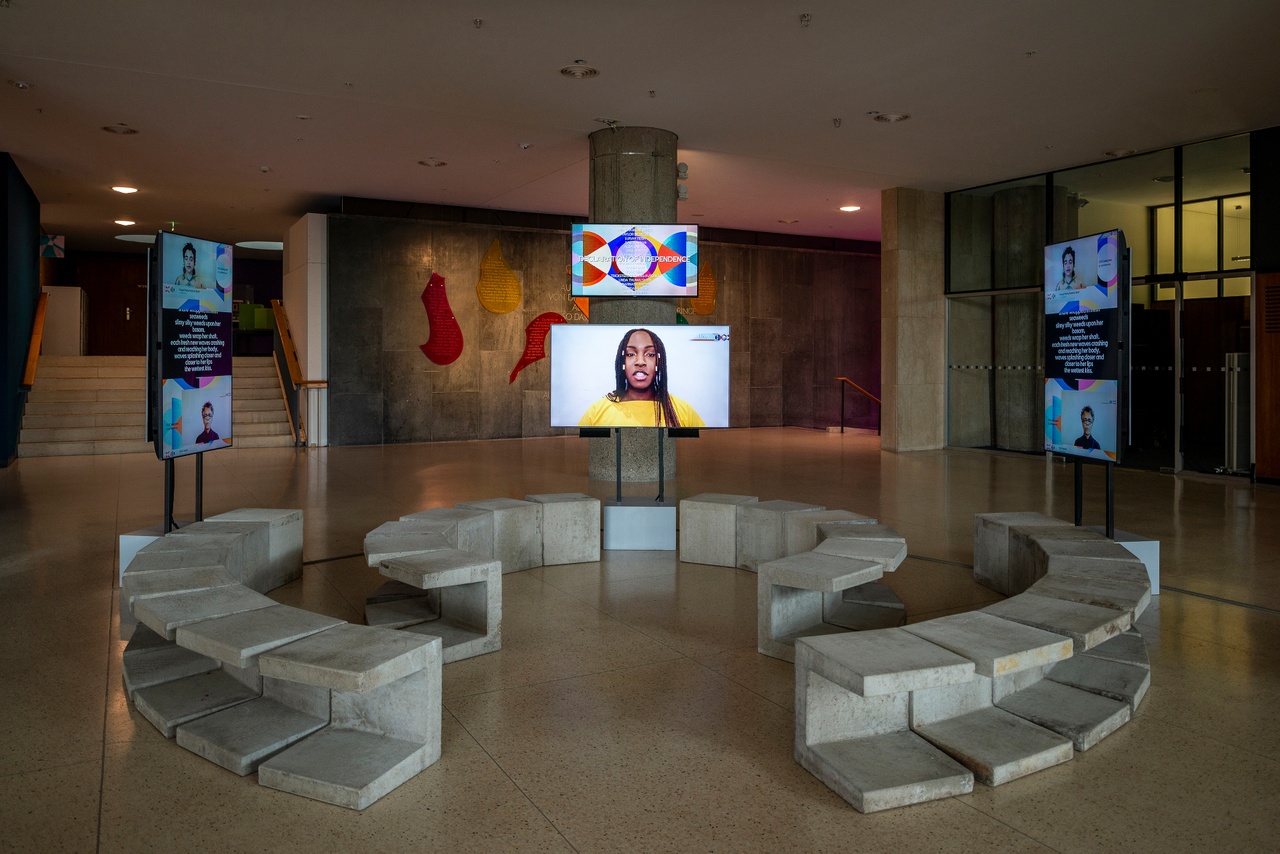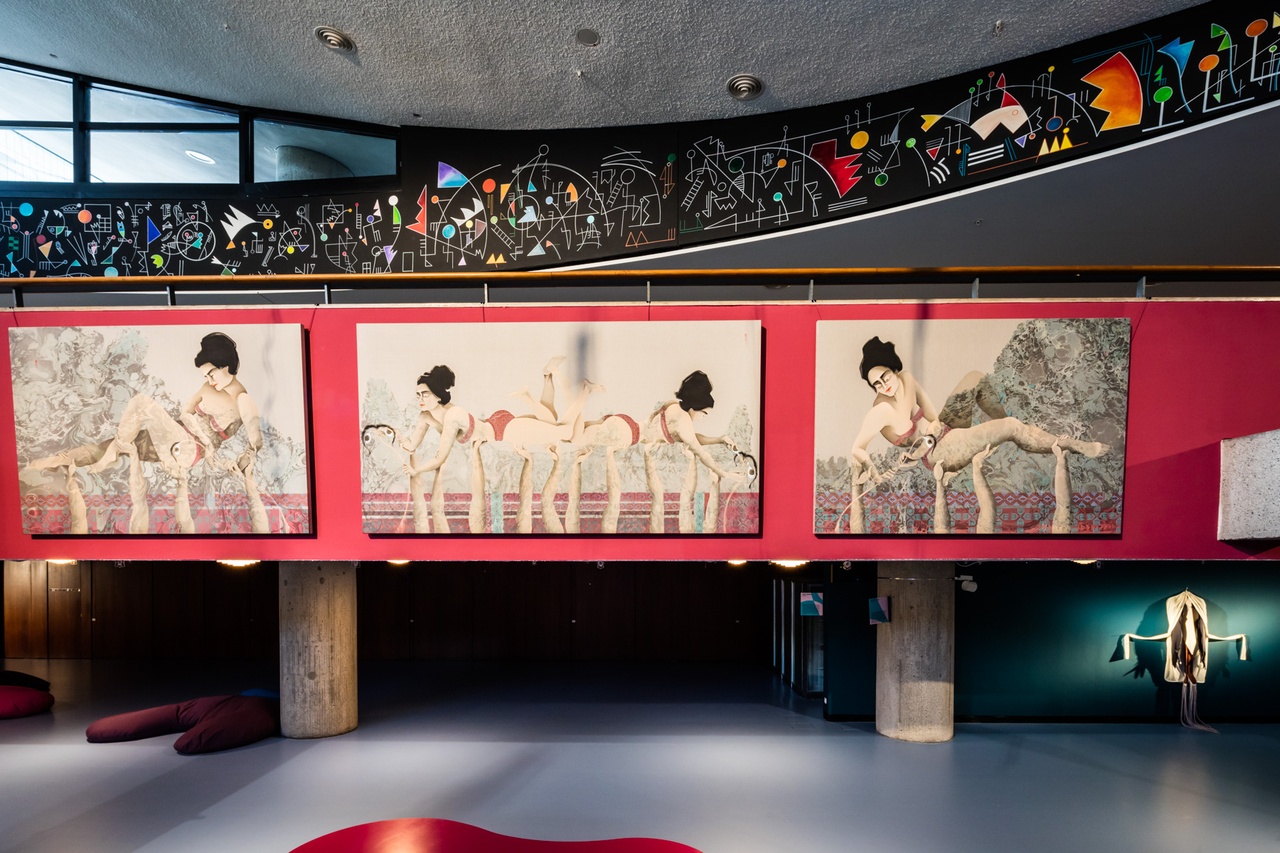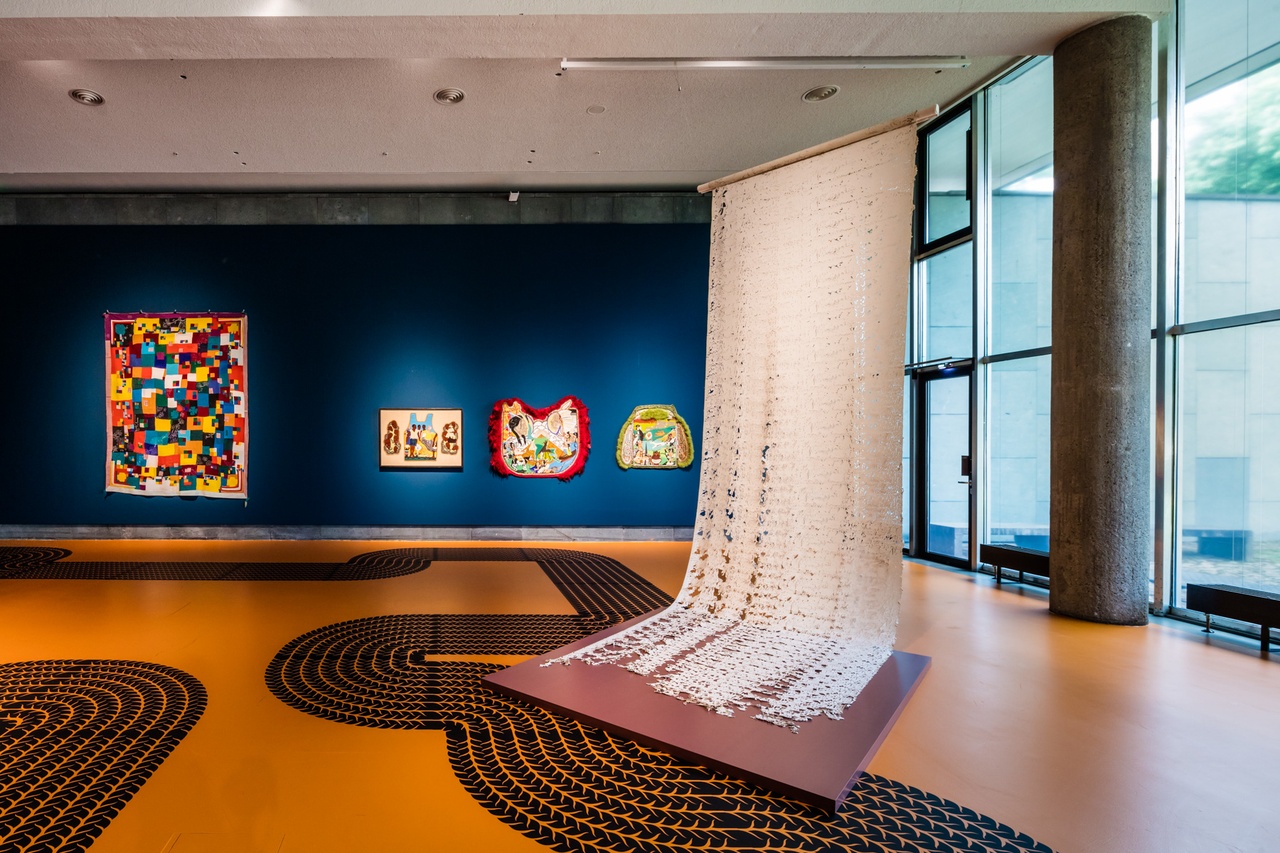O QUILOMBISMO AS A VERB Kathy-Ann Tan on “O Quilombismo” at Haus der Kulturen der Welt, Berlin

Barby Asante, “Declaration of Independence,” 2017–ongoing
The highly anticipated reopening of Haus der Kulturen der Welt (HKW), which included a series of talks, performances, rituals, readings, concerts, and its opening exhibition “O Quilombismo,” took place from June 2 to 4 under the title “Acts of Opening Again: A Choreography of Conviviality.” A choreography it was indeed, as visitors were invited to enter the building together following a ceremonial opening convened by the Haitian Sèvitè Houngan (Vodou priest) Jean-Daniel Lafontant and the performance ritual “When We Gather” by Cuban-born artist María Magdalena Campos-Pons. The audience was then encouraged to follow a score that meant meandering through the entirety of the newly-named interior spaces of the building – the Sylvia Wynter Foyer, the Beatriz Nascimento Hall, the Gloria Anzaldúa Stairs, and so on –, nodding in recognition of the work of women philosophers, poets, activists, and artists who have been marginalized in the grand narratives of history. An estimated 15,000 visitors attended the opening weekend, and VIP-spotting became an unofficial part of the program.
Despite Berlin’s varied arts scene, the number of BIPOC-led and -run spaces and institutions that center non-white, non-western arts, cultures, languages, histories, and, correspondingly, the work of artists from the “Global South,” remains to be counted on one hand. There are galleries and spaces like SAVVY Contemporary, Oyoun, and the space that I run, Mental Health Arts Space (MHAS). Then there are community-based empowerment associations, initiatives, and projects like Each One Teach One (EOTO) and Casa Kuà, a queer community and health center run by trans* and nonbinary BIPOCs. This is why, when it was announced that SAVVY Contemporary founder and longtime head Bonaventure Soh Bejeng Ndikung would take up directorship of HKW as of January 2023, many welcomed it as a turning point in Berlin’s artistic and cultural institutional history, as the dawn of a new era. Nevertheless, several questions simultaneously arose: Can a space like HKW ever be completely conceived anew, and how much autonomy can the new director and his team have if the institution’s structures of power, funding, and patronage ultimately stay the same? How can artistic and curatorial strategies of resistance, freedom, conviviality, and experimentation be practiced within such a German bureaucratic space, HKW being one of the four cultural institutions that comprise the KBB – Kulturveranstaltungen des Bundes in Berlin? Is this what institutionalized radicality looks like?

Hayv Kahraman, “Untitled,” 2023
These questions came to the fore as I visited the exhibition “O Quilombismo: Of Resisting and Insisting. Of Flight as Fight. Of Other Democratic Egalitarian Political Philosophies.” Drawing upon the concept and practice of quilombismo, the exhibition professes to be “an invitation [to] imagine what cultural resistance of our contemporary condition(s) could be, and how this might be informed by the cultural resistances and emancipation schemes of the past.” [1] Extrapolated from its original context of living in freedom and economic egalitarianism in the quilombos, remote communities in colonial Brazil organized by fugitive enslaved Africans, quilombismo as a political philosophy was popularized during Black liberation movements in Brazil in the second half of the 20th century to mean revolt, resistance, struggle, marronage, freedom, emancipation, encounter, and solidarity. This is the meaning that has carried over into the present day. I start the exhibition in the aptly-named Sylvia Wynter Foyer, which features several works by Black women and women of color – from British Ghanian artist Barby Asante’s video installation based on her ongoing, multi-episodic, dialogic, and collaborative series of performance interventions, Declaration of Independence (2017–ongoing), which centers the knowledges, experiences, freedom, and thriving of Black women, to the eight oversized oil-on-linen canvases by Iraqi American painter Hayv Kahraman, wherein women of color merrily deconstruct white, Eurocentric notions of beauty and femininity, to Moroccan architect, artist, and jewelry designer Amina Agueznay’s site-specific commissioned installation Assetta #2 (2023), which transforms several columns of the foyer from cold concrete pillars into intricate artworks by way of airy, protective coverings made out of henna-dyed wool yarn spun on metal wire.
Visually and thematically, Agueznay’s column installations conversed with several different works in the exhibition that embodied the notion of flight as fight, of the delicate and lattice-like airy structure as something that actually belies a body of resistance and strength underneath. Several works in the Mrinalini Mukherjee Hall illustrated this, from Trương Công Tùng’s floor-to-ceiling work Blind Map (2013), a canvas roll punctured by the performative score of a colony of termites that references the occupation of the lands of the Jarai Indigenous community in the Central Highlands of Vietnam, to Jamaican Trinidadian artist Jasmine Thomas-Girvan’s large-scale graphite-on-paper installation The Healing Stream (2022). Suspended and unfolded like a scroll on black paper, the piece, which includes drawings and cut-outs, references the Royal Parchment Scroll of Black Supremacy written by proto-Rastafarian preacher Fitz Balintine Pettersburg in 1926, one of the central works in Rastafarian thought. The title of Thomas-Girvan’s piece stems from a Jamaican folk song that dwells in the power of healing throughout Black history and liberation struggles. Practices of (inter)weaving were also foregrounded in several works in the room, such as Ange Dakouo’s commissioned sculpture Imagine (2023), which weaves together a constellation of talismans held by cotton yarn and interspersed with mirrors encased in leather, as well as Zimbabwean artist Nontsikelelo Mutiti’s commissioned floor mural Kubatana (togetherness / unity / connecting / touching / holding) (2023), which depicts interwoven braids aligned in geometric shapes and patterns across the center of the exhibition hall, inviting the visitor to walk the path of braiding as a practice of African and Black diasporic ancestry and joy, kinship and beauty.
This invitation to physically, intellectually, and affectively meander and navigate your way through the “O Quilombismo” exhibition is accompanied by a series of walkthroughs facilitated every weekend by different members of the HKW team, from its director and chief curator Bonaventure Soh Bejeng Ndikung, to Eric Otieno Sumba and Jill Winder from the publication practices division, and Marie Helene Pereira from the performative practices division and senior curator of HKW. These participatory walkthroughs provide a nice touch to the exhibition program, opening up different perspectives on the artworks and supplying valuable background on the exhibition’s overall curatorial concept and vision.

Trương Công Tùng, “Blind Map,” 2013
True to its belief in quilombismo as a verb that insists on inclusivity, egalitarianism, and accessibility, the exhibition program also incorporated “The School of Quilombismo” from June to August 2023, a self-described “free-roaming program that embodies and resonates with the imaginative, wayward, unorthodox, and self-determined pedagogical and knowledge practices of Africa and its diasporas.” [2] Seeking to bring together “those who incite discomfort in between and at the peripheries of positions and hierarchies” in the spirit of (un)learning, the extensive program of talks, workshops, and listening sessions was spread out across several institutional sites in Berlin including EOTO, Forum Brasil, and Spore Initiative, as well as online. “The School of Quilombismo,” with its focus on anti-exploitative, reparative, and generative structures and conditions of knowledge production and dissemination, no doubt illustrates a version of fugitive planning and Black study that Fred Moten and Stefano Harney called for in their seminal work The Undercommons (2013).
It remains to be seen, a year or several out from now, if HKW will still be able to sustainably implement its project, as “O Quilombismo”’s program concept declares in Sylvia Wynter’s words, of carving out and holding “a free space from where to wage the ongoing process of revolt against the cultural colonization,” [3] a space of integrity, possibility, and encounter, co-existence, conviviality, and solidarity that is premised upon Black liberation, anti-colonial struggle, and revolution, as well as the invaluable nature of Black and Indigenous knowledges and cultures. A federally run and funded cultural institution sits, in my opinion, too close to national politics to be able to enact the kind of visionary revolt and overhaul that the new director of HKW and his team envisage for HKW as a place of resistance and quilombismo. For me, the nation-state and its structures of jurisprudence, control, and governance will always sit incompatibly, and in conflict with, the embodiment of an anti-colonial politics of liberation, autonomy, and radicality that characterizes the act of quilombismo as a verb. With such a massive structural challenge in sight, I sincerely hope that “O Quilombismo” will continue to be a rallying cry, and not a sigh of lament. Everything hangs upon.
“O Quilombismo: Of Resisting and Insisting. Of Flight as Fight. Of Other Democratic Egalitarian Political Philosophies,” Haus der Kulturen der Welt, Berlin, June 2–September 17, 2023.
Other texts on this topics have been contributed by Luce DeLire and Nina Möntmann.
Kathy-Ann Tan is a Berlin-based independent curator, writer, and founder of Mental Health Arts Space (www.mhasberlin.com), a nonprofit project space that centers the mental health, knowledge, histories, and narratives of BIPOC and minoritized artists and cultural workers. She is interested in alternative and sustainable forms of art dissemination, cultural production, and institution-building that are committed to issues of social justice beyond a merely representational model of identity politics. Tan’s practice revolves around creating spaces for conversation, sharing, and empowerment for BIPOC and minoritized communities in the arts and cultural scenes in Berlin and beyond. As a former full-time academic, she has extensive experience in teaching, research, publishing, and public speaking.
Image credit: 1.+2. Courtesy of the artists, photo Laura Fiorio/HKW, Berlin; 3. Courtesy of Post Vidai Collection, photo Laura Fiorio/HKW, Berlin
Notes
| [1] | Bonaventure Soh Bejeng Ndikung, O Quilombismo Handbook (Berlin: HKW and Archive Books, 2023), 16. |
| [2] | “School of Quilombismo,” June–August 2023, Haus der Kulturen der Welt, https://www.hkw.de/en/programme/school-of-quilombismo. |
| [3] | Sylvia Wynter, “Black Metamorphosis: New Natives in a New World,” cited in O Quilombismo Handbook, 7; and the exhibition website, https://www.hkw.de/en/programme/o-quilombismo. |
